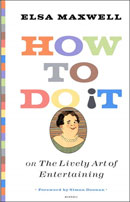Books |
How to Do It, or The Lively Art of Entertaining
Elsa Maxwell
By
Published: Jan 01, 2005
Category:
Memoir
"Even the greatest hostess is forgotten when the last of her guests dies." Don’t you wish you’d written that line? Me too. The truth is, I borrowed it from George Painter’s great biography of Marcel Proust. So can you. In fact, steal it. Call it your own. These days who reads two volume biographies of Marcel Proust?
Anyway. If great hostesses are the ultimate in ephemera, how is it that we — well, some of us, anyway — still know who Elsa Maxwell is?
She was, after all, no raving beauty. Far from it. She was a tubby specimen with a round face and a spare chin. Breeding? Born in Keokuk, Iowa. Education? She left school at 14. Career? Well, she started off as a theater pianist before moving on to vaudeville songwriting.
Not a very promising start. But in her 20s, she began to meet Important People — and to become their New Best Friend. By 1918, she was a Hostess, and her guests included actors, Society types and Royals. What was the attraction? Elsa gave them fun. She invented the "scavenger hunt." She threw costume balls. She invited celebs to compete as chefs. And she kept things…light.
She would go on to play herself in movies, host a radio show, write a gossip column. But that was just…work. Her pleasure never changed: hosting the swells. That was always her playing field, and no one knew it better — she got Frank Sinatra to suck up to her, she introduced Maria Callas to Aristotle Onassis.
She was, as you might expect, a great talker. " I don’t hate anyone. I dislike," she said, making a distinction without a difference. "But my dislike is the equivalent of anyone else’s hate." She was the butt of her own jokes: "Always laugh at yourself first, before anyone else can." And she had a ready answer to her spinster status: " I married the world — the world is my husband. That is why I’m so young. No sex. Sex is the most tiring thing in the world."
She wrote a couple of books, and one of them, first published in 1957, is now back in print. Will this book teach you how to entertain? Only if you are living in a time capsule frozen in the 1950s. No, this is sociology. This is a look into a privileged world that once was as stable as the American dollar and now seems deader than disco.
I’ve given 2,000 parties over 40 years, she tells us. Those were 40 good years. Look at history. In the great periods, "women figured importantly and the art of entertaining rode high." So, for Maxwell, giving a memorable party kind of…lifts an entire decade. (She quotes a friend who claims that life itself is a party: "You join after it’s started and leave before it’s finished." That’s what passed for Deep Thought in her circles.)
Her party advice won’t be of much help. Here’s an Elsa Maxwell dilemma: what kind of party to give for Cole Porter? A special one, of course. How about…two hundred songbirds, singing, in decorative cages. Pink flowers. Oh, and all the men in white tie.
This kind of entertaining requires a wheelbarrow filled with money; it also calls for total self-confidence. That was a Maxwell signature: "In me, self-confidence amounts to original sin." No wishy-washy opinions for her. She’ll tolerate a cocktail party; she prefers a dinner party. And guests who like to play canasta or bridge — divine!
And her views on women! "A woman who parades an abundance of education is giving herself an awful handicap socially….Women who know too much are not going to be popular with men." My my my. To her credit, she is just as tough with men who come to parties even though they’re clearly bored. Her solution: Have books by the door, near a handy servant. Tell the man, "You’re not happy — and if you’re not happy, I’m not either. You need to be in bed with a good book." And then grab a book from her footman and shove the dumb lug out the door. (Try that at your next shindig!)
There are some priceless recipes at the end, on the order of "cold eggs with ham and tarragon" — it begins, "cover the bottom of a silver serving dish with a fine meat jelly," but you get the idea. This food — crepes, veal in sour cream, cheese pie — would kill you in a week. How Maxwell’s guests ate this stuff, drank themselves silly and remained thin is one of the greater mysteries.
I’m not mocking. This is a hugely enjoyable book, precisely because it’s so alien to everything we know. And yet all this happened less than a century ago. Things change. And fast. For those who wish they could were young — or were young — back in the days of flasks and cigarette cases and witty banter, this book will be a lark. For the rest of us, it will just be one weird ride.
To buy "How to Do It" from Amazon.com, click here.


